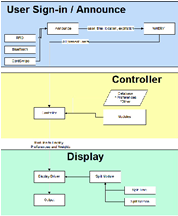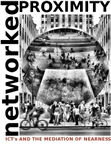Jan 31, 2007
Many Eyes
IBM (Quote) launched a new social computing site today called Many Eyes, which allows users to upload very large data sets, choose different visual representations for the data sets, and engage in an online discussion of what the data reveals. Each visualization will allow for an active discussion to take place and become a common area to share ideas, add insight and understand the visualization in a group setting.
(…)
an attempt to learn whether the principles of crowd-sourcing can be applied to the analysis of visualized data, in the hopes of generating broader and deeper analysis of data.
(source: Internet News)
17:20 Posted in Social Media | Permalink | Comments (0) | Tags: social computing
Jan 25, 2007
Prospero - A "Visual Commons" Framework for Community-Aware Public Displays
Re-blogged from Networked Performance

Information about the community as a commons and about commons in the community can be useful for promoting a sense of shared fate and shared identity. In addition, as mobility increases, information about how a community moves into, out of, and through its spaces (such as public commons) can be a useful source of community feedback. A new project at the University of Michigan investigates using public displays to understand and represent community dynamics and preferences:
Prospero is an infrastructure to enable public displays to reflect evolving public participation. The objectives of the Prospero project arise from two primary motivations: one descriptive, the other normative. First, technologies that foster cooperation enhance our relationship to our surroundings. Many of these technologies incorporate user feedback in real-time.
Second, our team members believe that a society in which collective decision-making is based on participatory democracy and public resources should be allocated not by top-down or centrally-controlled mechanisms, but on the basis of the expressed desires and needs of participants. As cooperation increases, we have seen a resurgence of "the commons," i.e. that public sphere in which community values are expressed.
In our project, we shall explore this theme through its instantiation in the specific domain area of public displays. In much of modern life, public spaces, public media and public art are designed to send us messages that we passively receive, process and absorb. However, we believe that in a democracy, citizens must actively shape the public sphere. This necessitates "talking back" to the elements that constitute the public sphere. Public displays, that is, displays located in public spaces and accessible to a public, constitute an increasingly important element of the public sphere. We will develop an infrastructure for community-aware public displays that are controlled by users' expressed needs and preferences; we see our endeavor as part of an ongoing, democratic reclaiming, by citizens, of control over an increasing number of aspects of the public sphere in general.
Thus, by making a public display that is attentive to its community of users, a Visual Commons, it becomes possible for the community to escape the present hegemony of one-way communication, or "broadcast," of generic information (such as the time, or stock prices) or the barrage of mass-media advertising (such as occurs in New York City's Times Square). In effect, dynamic processing of community feedback regarding the contents of the display enables it to become more than just a billboard.
22:00 Posted in Information visualization, Social Media | Permalink | Comments (0) | Tags: social computing
Dec 29, 2006
Networks as Metaphors and Models

Networks have become a powerful metaphor for explaining the social realities of our times. A network, defined minimally, is a system of interconnected elements or nodes, where each node represents an intersection of flows within the network. Everywhere we look there are attempts to explain all kinds of social formations in terms of networks: citizen networks, corporate networks, gamer networks, terrorist networks, learning networks, networks of production, networks of distribution... and so on. The metaphor of the network can be superimposed over just about any form of multiplicity, including non-social ones (for instance, cells in the brain can be described in terms of a network). For the purposes of this study, however, every reference to networks, unless otherwise specified, is meant to allude to technosocial assemblages in which ICT's facilitate social relations between humans unconstrained by the physical distance between them. If Cognitive Science attempted to explain individual consciousness by adopting the metaphor of the brain as a computer, with its inputs and outputs, Social Science is extending the metaphor a step further by attempting to explain the social in terms of networks-or, in this context, sets of interconnected computers/brains."
Continue reading Networked Proximity - Section 1 by Ulises Ali Mejias. Also see Networked Proximity - Introduction.
21:40 Posted in Social Media | Permalink | Comments (0) | Tags: social networks
Dec 28, 2006
Tokyo Ubiquitous Network Project
Via 3DPoint

The Tokyo Ubiquitous Network Project seeks to outfit Tokyo’s high-end shopping district, the Ginza, with 10,000 RFID tags and other digital beacons. The project, led by Ken Sakamura, a professor at the University of Tokyo, will bring location-based information to people carrying prototype readers developed for the trial.
From the PC Advisor article:
“Bringing the terminal close to an RFID tag on a street lamp will pinpoint the user’s location and the system will be able to guide them to the nearest railway station, while walking past a radio beacon in front of a shop might bring up details of current special offers or a menu for a restaurant.”
20:11 Posted in Locative media, Social Media | Permalink | Comments (0) | Tags: social networks, locative media
Dec 20, 2006
Mobile social networking growing
Re-blogged from Mobile blog
ABI Research have released news that they believe users of mobile social networking will rise to more than 170 million by 2011, up from the estimated 50 million now."
The rapid rise of online social communities - gathering places such as MySpace and Facebook - has done more than bring the 'pen pal' concept into the 21st century," says vice president of research Clint Wheelock. "It has created a new paradigm for personal networking. In a logical progression, many social communities are now based on the mobile phone and other portable wireless devices instead of (or as well as) the PC. Such mobile social communities extend the reach of electronic social interaction to millions of people who don't have regular or easy access to computers."
23:00 Posted in Social Media | Permalink | Comments (0) | Tags: mobile social software
Key players in mobile social software
key players in the MoSoSo arena:
Dodgeball, Enpresence, Jambo Networks, Loopt, Mologogo, My MoSoSo, Pinppl, PlaceSite, Plazes, Saki Mobile, Nokia Sensor, Microsoft SLAM, Vixo, Zingku
22:45 Posted in Social Media, Wearable & mobile | Permalink | Comments (0) | Tags: mobile social software
Dec 03, 2006
2D Web-to-Second Life importer
Via 3D Point

A browser called 3B that allows you take existing 2D Web content and make an avatarized 3D space out of it that others can visit. From the site:
“3B allows you take any web sites or photos and place them in a personalized 3D space, your 3B village. You can use MySpace, Hi5 or Bebo pages or photos you’ve loaded onto Flickr, Photobucket or any other web service.”
12:35 Posted in Social Media | Permalink | Comments (0) | Tags: social computing
Rhythms of social interaction

From Smart Mobs
Rhythms of social interaction: messaging within a massive online network (PDF) by Scott Golder, Dennis Wilkinson, and Bernardo Huberman:
"We have analyzed the fully-anonymized headers of 362 million messages exchanged by 4.2 million users of Facebook, an online social network of college students, during a 26 month interval. The data reveal a number of strong daily and weekly regularities which provide insights into the time use of college students and their social lives, including seasonal variations. We also examined how factors such as school affiliation and informal online “friend” lists affect the observed behavior and temporal patterns. Finally, we show that Facebook users appear to be clustered by school with respect to their temporal messaging patterns.
12:14 Posted in Social Media | Permalink | Comments (0) | Tags: social computing
Nov 28, 2006
bliin YourLIVE!
Re-blogged from Mauro Cherubini's moleskine
bliin YourLIVE! is a social networking service where users can spot, trace and share experiences — pictures, videos, audio and text — with one another in real-time on a Google Map.
Users create ‘bliins’ to navigate and monitor their interests in a location or area. bliins can be saved and shared amongst users. bliin is powered by GeoTracing and built on KeyWorx.
23:58 Posted in Social Media | Permalink | Comments (0) | Tags: social computing
Nov 07, 2006
SLAM - Mobile social networking from Microsoft Research
Via LADS
SLAM is a mobile based social networking application deveoped by Microsoft Research’s Community Technologies Group, which enables lightweight, group-centric real-time communication, photo-sharing and location awareness.

From LADS:
From the user perspective, “Slam” means a group of people with whom you can share you exchange messages and share photos easily through your mobile phone. Slam works on group level, which means that any messages sent to a Slam gets delivered to all the members in the group. To use Slam you need to install the Slam application on your Windows Mobile based devices and need a unlimited data plan. So any messages sent from your smart phone will be over HTTP instead of using SMS. If you don’t have Windows based device, you can still communicate with your Slams through SMS, since each Slam has a different phone number to enable SMS delivery.
Slam delivers a pretty impressive feature set on the smart phones. Besides exchanging messages, users can view private and public Slams, create Slam, invite people to an existing Slam, join Slams, view Slam members, view and upload photos, manage their Slams, and view unread messages. While viewing a member profile Slam also indicates if you the user has any an intersecting Slam group with you.
One of the best features Slam team is working on is to provide location information of people in your Slam group. Once group members set their privacy level to allow appropriate Slam groups to view their location information, Slam maps the location information onto a Windows Live map on your mobile. This feature is more of a proof of concept and works only on few phone including Audiovox 5600, I-Mate Sp3 and i-Mate SP5 for some of the Seattle users of Cingular/AT&T and T-Mobile.
Visit also the Microsoft Slam Team Blog
00:00 Posted in Locative media, Social Media | Permalink | Comments (0) | Tags: social networks, locative media
Oct 30, 2006
Flickr Graph
Flickr Graph is an award winning application (FITC awards 2005) developed by Marcos Weskamp that explores the social relationships inside flickr.com. It makes use of the classic attraction-repulsion algorithm for graphs.
Try Flickr Graph here
15:50 Posted in Information visualization, Social Media | Permalink | Comments (0) | Tags: social network analysis, information visualization, complex networks
Oct 26, 2006
Social network vizster
Re-blogged from InfoAesthetics

Vizter is a sophisticated social network data visualization system that end-users of social networking services can use to facilitate discovery & increased awareness of their online community. vizster presents social networks using a simple network node-link representation, where nodes represent members of the system & links represent the articulated 'friendship' links between them. network members are depicted using both their self-provided name & a representative image. the networks are presented as 'egocentric' networks, consisting of an individual & their immediate friends. users can expand the display by selecting nodes to make visible others’ immediate friends as well. in addition, inferred community groupings of two or more nodes are visibly represented as 'blobs' surrounding community members, taking advantage of low spatial frequencies to make community structures apparent.
20:05 Posted in Information visualization, Social Media | Permalink | Comments (0) | Tags: social network data visualization system
Oct 11, 2006
New network theory
2007 ASCA International Conference
Location: Amsterdam Dates: 28-30 June 2007
Organized by the Amsterdam School for Cultural Analysis (ASCA), the Institute of Network Cultures (Amsterdam Polytechnic) and Media Studies at the University of Amsterdam, has issued its first call for papers. The conference, to be held on Thursday, 28 June to Saturday, 30 June, 2007, also includes a public program with renowned speakers.
Deadline for Submission of Paper Abstract (500 words) and Biography (100 words): 10 January 2007 :: Submit to: networktheory[at]networkcultures.org :: Acceptance Notification: 1 March 2007 :: Further inquiries to: Dr. Eloe Kingma, Managing Director, Amsterdam School of Cultural Analysis, Oude Turfmarkt 147, Oude Turfmarkt 147, 1012 GC, Amsterdam, tel: +31 20 525 3874, asca-fgw[at]uva.nl.
The object of study has shifted from the virtual community and the space of flows to the smart mob. When the object of study changes, so may the distinctions that dominate, particularly the schism between place-based space and place-less space, both organised and given life by networks. We would like to exploit the potential of writing contemporary network theory that suits and reflects the changes to the objects of study that come to define our understandings of network culture - a post-Castellsian network theory, if you will, that takes technical media seriously.
It is time to look for elements that can make up a network theory outside of post-modern cultural studies (which marvelled at the place-less place) and ethnographic social sciences (which reminded us of the ground). What network culture studies needs is a `language of new media,' perhaps even signage, to speak in terms of Lev Manovich; what it currently has is a science-centered `unified network theory,' to paraphrase the language of Albert-László Barabási.
Whilst it may come as no surprise to critical Internet scholars, the notion that networks are not random but have underlying structures remains the key insight for network scientists. Instead of posing new questions, the work that follows from that insight often seeks to confirm that structure and its accompanying patterns, across more and more network-like objects. The question remains which specific contribution critical Internet scholars and practitioners can make to opening up network thought. Such is the purpose of the network theory conference. How must we rethink network culture with a renewed emphasis on technical media and social software?
Suggested Topics:
Networking and Social Life
Social Software and Insider Networks
Network Policy
Network Governance / Organised Networks
Actor-Network Theory and the Assemblage
Network Knowledge Production
Networks and Disengagement
Media Networks
The Link
Locative Media and Networks
22:05 Posted in Social Media | Permalink | Comments (0) | Tags: complex networks
May 15, 2006
Group Cognition

Innovative uses of global and local networks of linked computers make new ways of collaborative working, learning, and acting possible. In Group Cognition Gerry Stahl explores the technological and social reconfigurations that are needed to achieve computer-supported collaborative knowledge building--group cognition that transcends the limits of individual cognition. Computers can provide active media for social group cognition where ideas grow through the interactions within groups of people; software functionality can manage group discourse that results in shared understandings, new meanings, and collaborative learning. Stahl offers software design prototypes, analyzes empirical instances of collaboration, and elaborates a theory of collaboration that takes the group, rather than the individual, as the unit of analysis.
Stahl's design studies concentrate on mechanisms to support group formation, multiple interpretive perspectives, and the negotiation of group knowledge in applications as varied as collaborative curriculum development by teachers, writing summaries by students, and designing space voyages by NASA engineers. His empirical analysis shows how, in small-group collaborations, the group constructs intersubjective knowledge that emerges from and appears in the discourse itself. This discovery of group meaning becomes the springboard for Stahl's outline of a social theory of collaborative knowing. Stahl also discusses such related issues as the distinction between meaning making at the group level and interpretation at the individual level, appropriate research methodology, philosophical directions for group cognition theory, and suggestions for further empirical work.
21:50 Posted in Social Media | Permalink | Comments (0) | Tags: Positive Technology
Jan 22, 2006
Mindpixel founder Chris McKinstry announces his suicide online
Chris McKinstry, founder of the Mindpixel project, has expressed suicide intentions on his blog.
Two postings appeared on Friday, 20 January 2006, suggesting that McKinstry has committed suicide by drug overdose.
The wikipedia entry on Chris McKinstry has been upgraded on Friday with his suicide announce. This contains a link to a forum, where he re-posted the suicidal note appeared on his blog. McKinstry said he was posting from an Internet cafè in Chile. Forum participants have tried to dissuade McKinstry and to identify his precise location in Chile tracking the IP address. They also contacted the US embassy in Santiago, which turned the case over to the Canadian embassy (McKinstry is a Canadian citizen).
There have been no new postings on the forum since yesterday morning.
18:05 Posted in Social Media | Permalink | Comments (0) | Tags: Positive Technology, complex networks
Sep 19, 2005
Collective intelligence - The Transitioner
Down through the media, overhead machineries will make us hear the voice of the multiple. Still indiscernible, soften by the hazes of the future, flooding another humanity with its murmur, we have an appointment with the surlanguage
Pierre Lévy – "Collective Intelligence"
 The Transitioner.org is wiki which brings together those who want to marry the economy and Collective Intelligence in order to build a fair world.
The Transitioner.org is wiki which brings together those who want to marry the economy and Collective Intelligence in order to build a fair world.
Discover here if you are a transitioner (I discovered I am)
More to explore
Blog of Collective Intelligence
Improving the efficiency of social ecosystems
13:05 Posted in Social Media | Permalink | Comments (0) | Tags: Positive Technology, complex networks








